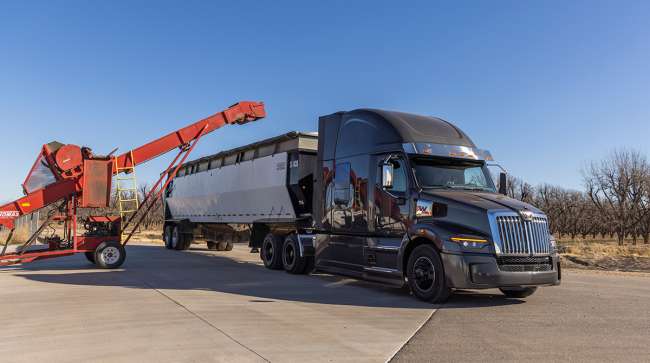Staff Reporter
September Class 8 Retail Sales Fall 1.9% Year Over Year

[Stay on top of transportation news: Get TTNews in your inbox.]
U.S. Class 8 truck retail sales fell year over year in September for a second consecutive month and the eighth month out of nine so far in 2024. However, sales rose on a month-on-month basis.
Truck sales in September fell 1.9% to 21,813 vehicles from 22,231 units last year. But sales increased 5.5% from 20,671 units reported in August. Year-to-date sales were down 12.3% to 177,368 units from 202,335.
While Class 8 September retail sales were still down year on year, the percentage drop was much lower compared with the overall drop year-to-date, noted FTR Transportation Intelligence Senior Analyst for Commercial Vehicles Dan Moyer.
“Retail demand appeared to be holding up well,” said Moyer. “So all in all, decent results for the month.”
“The sales growth trend appears to be heading in the right direction,” Moyer said in an email. “And looking at it from another lens, given the continuing stagnation in the Class 8 truck freight market from both a rate and volume perspective, the sales figures are actually somewhat positive.”

Tam
“Seasonally, the numbers were in the ballpark of where we expected them to be,” said ACT Research Vice President Steve Tam. “It was a solid performance, but there were no rock stars.”
Sales rose compared with the same month in 2023 at four of the seven major Class 8 truck brands.
Volvo Group unit Volvo Trucks North America saw sales rise 5.1% to 2,514 vehicles from 2,393.
“Overall, the industry [retail sales] were down 1.9% year over year, which was certainly not unexpected, but can be attributed to the low freight rates and overall low profitability for fleets in the current market conditions,” said Magnus Koeck, VTNA vice president, strategy, marketing and brand management.

Koeck
Western Star, a unit of Daimler Truck North America, posted the largest year-over-year increase in sales in percentage terms. Western Star sold 1,006 trucks in September, a 45.6% jump compared with 691 vehicles in the same period a year earlier.
Western Star sales swelled due to a vocational truck backlog clearance, Tam said, adding: “There’s lots and lots of [vocational] demand and that’s going to be good for the rest of the year and in 2025.”
“September delivered solid Class 8 retail sales performance. While we continue to navigate challenges in the freight market, we’re encouraged by the sustained demand in the vocational segment,” said Jonathan Randall, president of Mack Trucks North America.
“The robust construction spending and manufacturing investment are positive indicators for our sector,” Randall added.
Mack Trucks sales saw the biggest year-on-year percentage decline, decreasing 28% to 1,168 units from 1,622 in the year-ago period. Mack is also a unit of Volvo Group.
Sales at International Motors, which was known as Navistar until Oct. 1, fell 15.5% to 2,705 trucks from 3,202.
Paccar Inc. unit Peterbilt Motors Co. sales declined 10.6% to 3,088 units from 3,456.
Freightliner, also a brand of DTNA, won the largest market share in September with 8,137 trucks sold, accounting for 37.3% of all sales in the month, and its total increased 3.4% from 7,869 in September 2023.
Kenworth Truck Co.’s sales rose 5.9% year over year in September to 3,176 Class 8 trucks from 2,998 units. Kenworth is also a Paccar subsidiary.
McLeod Software CEO Tom McLeod explores the potential for artificial intelligence to boost efficiency and build resilience. Tune in above or by going to RoadSigns.ttnews.com.
Truck dealers say the expected decline in retail sales in 2024 after the bumper 2023 is showing up in prices.
“We continue to see softness in the longhaul portion of the Class 8 market — and to a lesser but still notable extent, regional haul as well — due to relatively low freight volumes,” Kriete Truck Centers Executive Vice President of Sales David Barletta said in an email.
“As a result, we’re operating in a highly competitive environment when it comes to pricing in these sectors. While demand for vocational trucks, driven primarily by relatively good levels of construction activity, remains stronger, we’re starting to experience increasing competitiveness in this market segment as well,” Barletta said.
He added: “While it’s difficult to assess exactly to what degree, it’s not uncommon to see some pausing in capital equipment purchasing as presidential elections draw near.”
Also, demand is outstripping supply for particular models, which is hindering sales. Supply for some vocational models, particularly if a specific transmission is sought, cannot keep up with demand, said Robert Gomez, executive vice president of truck sales at Worldwide Equipment Enterprises.
There is cautious optimism for the coming months from dealers though.
Want more news? Listen to today's daily briefing above or go here for more info
“We hope to have a pretty good fourth quarter due to increased allotments and we should reap the benefits in Q4 and into the first quarter of 2025,” Gomez said.
“It’s … not unusual to see an uptick in Class 8 demand toward the end of the year, particularly in December, among customers looking to ensure their purchases occur in the current calendar year,” said Barletta, although that factor must be juxtaposed with the impact of November’s elections.
However, OEMs are not quite as confident about the prospects. “The market will most likely continue at a slow pace during [the coming] few quarters before we will see a turnaround, and then gradual increases in freight rates and profitability will start to fuel additional truck sales,” said VTNA’s Koeck.





